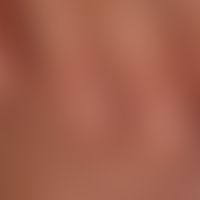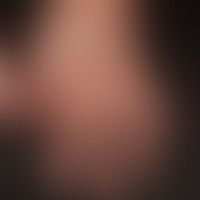Image diagnoses for "Plaque (raised surface > 1cm)", "Finger", "red"
31 results with 61 images
Results forPlaque (raised surface > 1cm)Fingerred

Fixed drug eruption L27.1
Drug reaction fixe: multilocular FA with incipient epidermolysis on sharply defined plaques on the back of the hand and fingers.

Mixed connective tissue disease M35.10
Mixed connective tissue disease. hyperkeratoticnail folds with elongated capillaries and focal haemorrhages. Note the splatter-like scars on the back of the fingers as well as the expression of focal, now healed scarred, cutaneous vascular occlusions.

Acrodermatitis continua suppurativa L40.2
Acrodermatitis continua suppurativa: chronic, recurrent, sterile pustular disease of the acromion, which leads to atrophy and loss of nails if it occurs repeatedly and persists for a long time (see figure).

Squamous cell carcinoma of the skin C44.-
Squamous cell carcinoma of the skin: carcinoma of the nail bed, which was misjudged as a fungal disease of the toenail and whose infiltrating growth had led to an almost complete onychodystrophy.

Dermatomyositis (overview) M33.-
dermatomyositis: reflected light microscopy. hyperkeratotic nail folds. pathologically enlarged and torqued capillaries. older bleeding into the nail fold.

Lupus erythematosus systemic M32.9
Lupus erythematosus systemic (late onset) characteristic "collagenosis hands" with persistent, acaral accentuated livid-red plaques, hypercratic nail fold and small hemorrhages. 83-year-old patient with known (since several years proven) systemic lupus erythematosus.

Psoriasis (Übersicht) L40.-
Nail psoriasis: unspecific nail dystrophy (which is also found in this way in chronic hand dermatitis), caused by paronychial infestation of the thumbs.

Nontuberculous Mycobacterioses (overview) A31.9
Mycobacteriosis atypical: Findings after 3 months of antibiotic therapy.

Nontuberculous Mycobacterioses (overview) A31.9
Mycobacteriosis atypical: chronic verrucous, blurred, painless, scaly plaque. aquarium owner.

Acute paronychia L03.0
Acute paronychia: with sharply limited red, only moderately painful swelling; laterally flaccid pustular formation.

Lupus erythematosus (overview) L93.-
Lupus erythematosus so-called chilbalin lupus: recurrent course for years; bluish-livid, painful plaques reminiscent of frostbite (chilblain).

Ringworm B35.2
Tinea manuum. coarse lamellar scaling in the area of the palm and the sides of the fingers without significant erythema.

Squamous cell carcinoma of the skin C44.-
Squamous cell carcinoma of the skin: carcinoma of the nail bed that has been present for several months (?), is mistaken for a fungal disease of the fingernail and is painful under pressure; onychodystrophy.

Acrodermatitis continua suppurativa L40.2
Acrodermatitis continua suppurativa:pronounced sterile-pustular, acral dermatitis with extensive destruction of the nails; the huat alterations are combined with severe arthritis psoriatica.

Dyshidrotic dermatitis L30.8
Dyshidrotic hand eczema: Condition following a large-bubble episode of dyshidrotic eczema.

Ringworm B35.2
Tinea manuum, impetiginierte: plaque on the back of the hand and forefinger that has existed for several months, accentuated at the edges, coarse lamellar scaling on the back of the hand and forefinger.moderate itching. increased weeping scaling in recent weeks. cultural evidence of Trichophyton rubrum.

Nontuberculous Mycobacterioses (overview) A31.9
Mycobacteriosis atypical: a blurred, painless lump that has existed for 12 weeks and developed from an "inconspicuous" papule.

Adult dermatomyositis M33.1
Dermatomyositis. 72 year old patient with dermatomyositis known for 1 year. striped red, scaly papules and plaques over the base of the fingers. deep red, painful and slightly scaly plaques on the end phalanges, also directly periungual. distinct hyperkeratotic nail folds.

Nontuberculous Mycobacterioses (overview) A31.9
Mycobacteriosis atypical: chronic verrucous, blurred, painless, scaly plaque. aquarium owner.

Dermatomyositis (overview) M33.-
Dermatomyositis: Flat red plaques on the end phalanges. Hyperkeratotic nail folds




